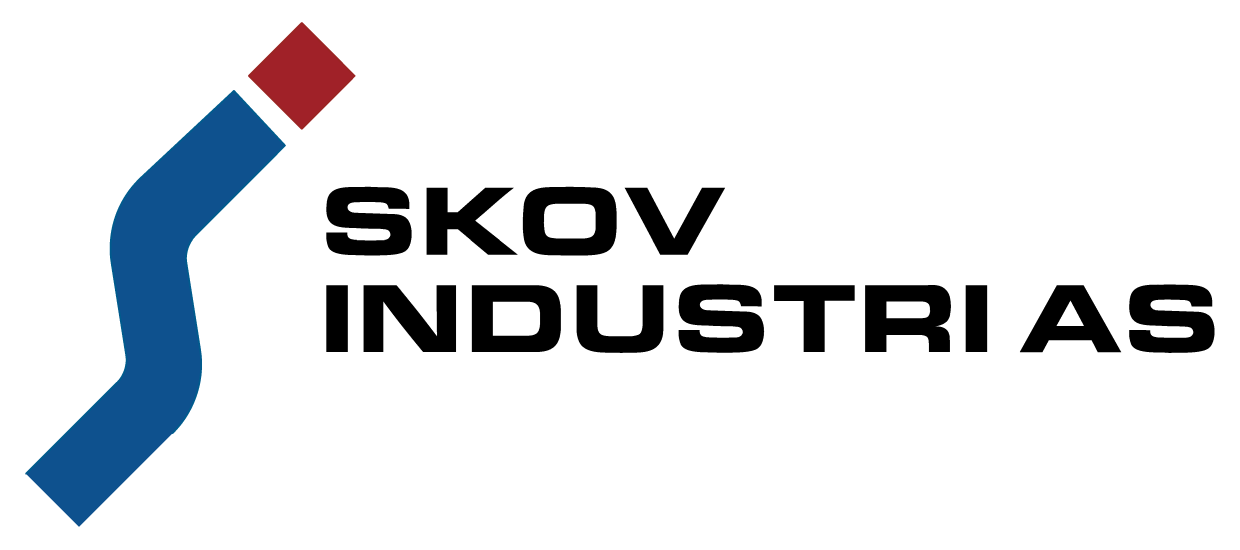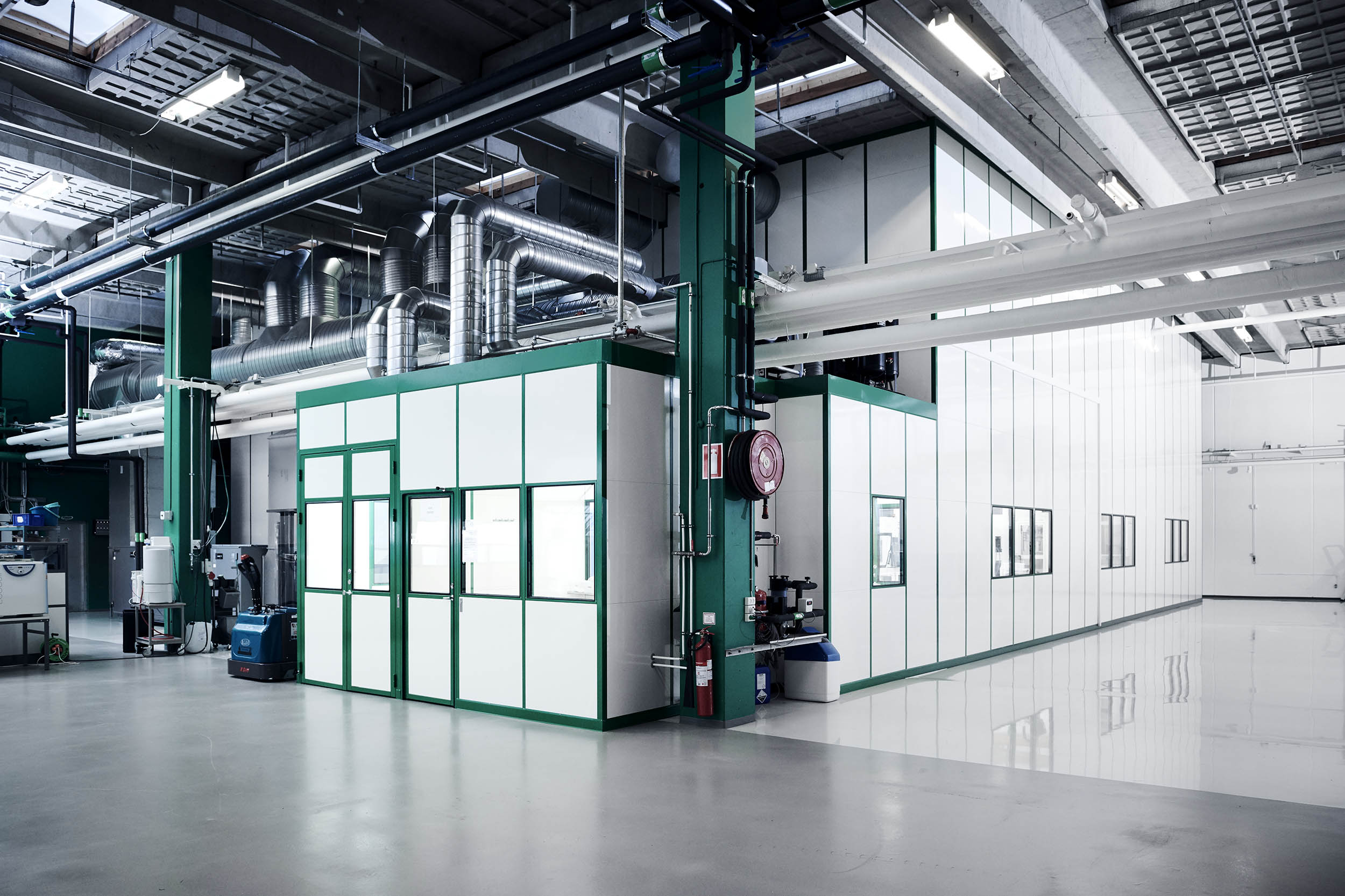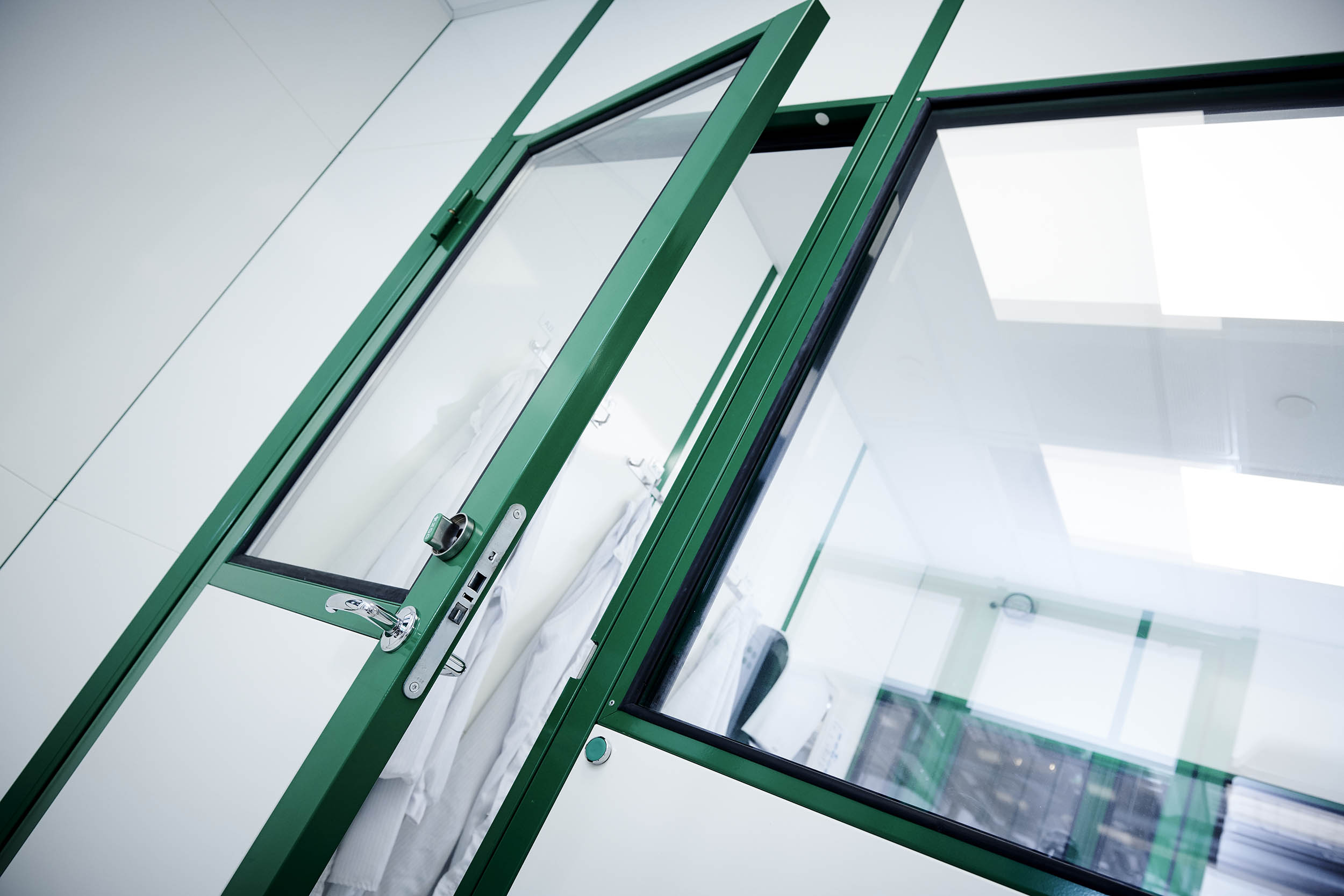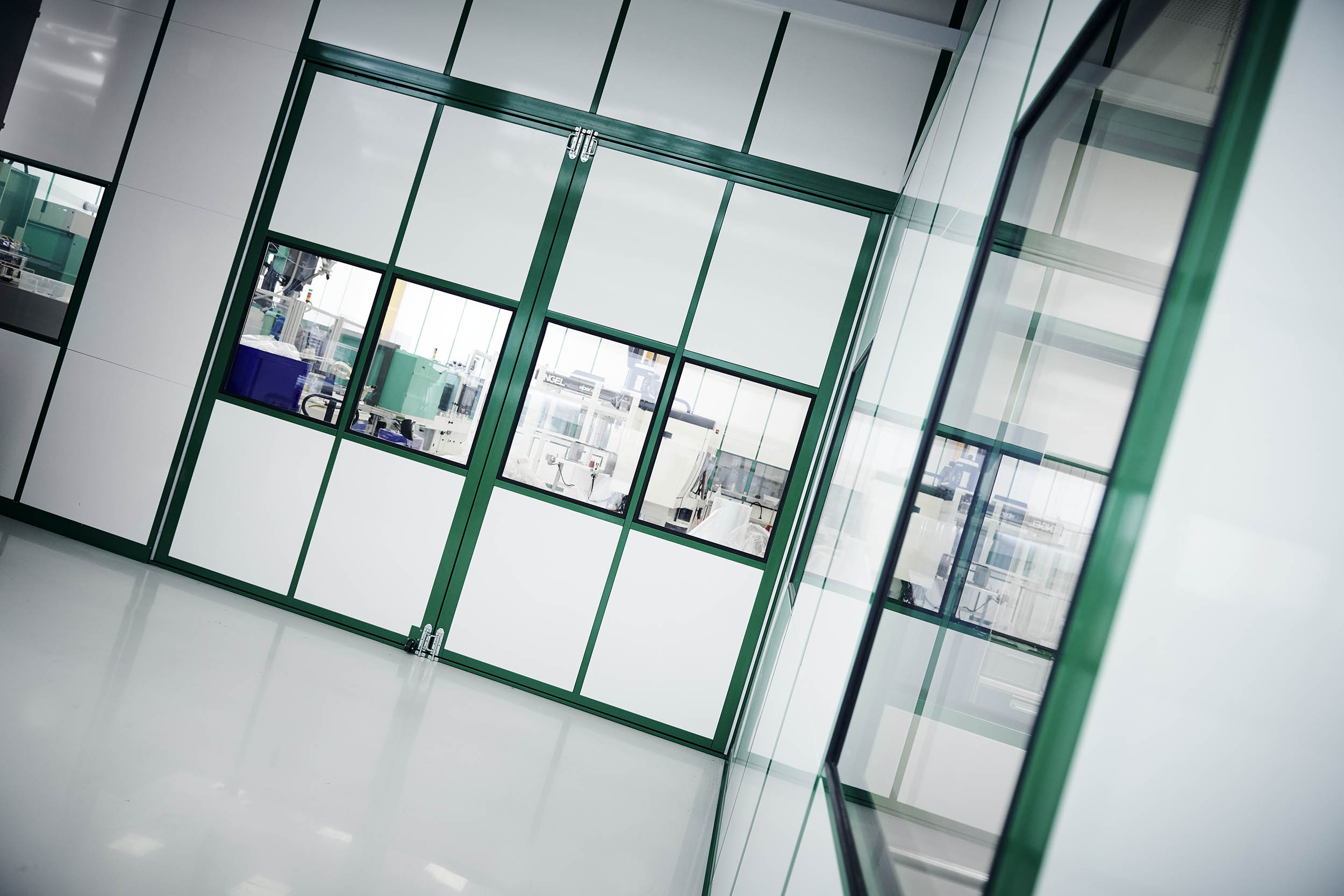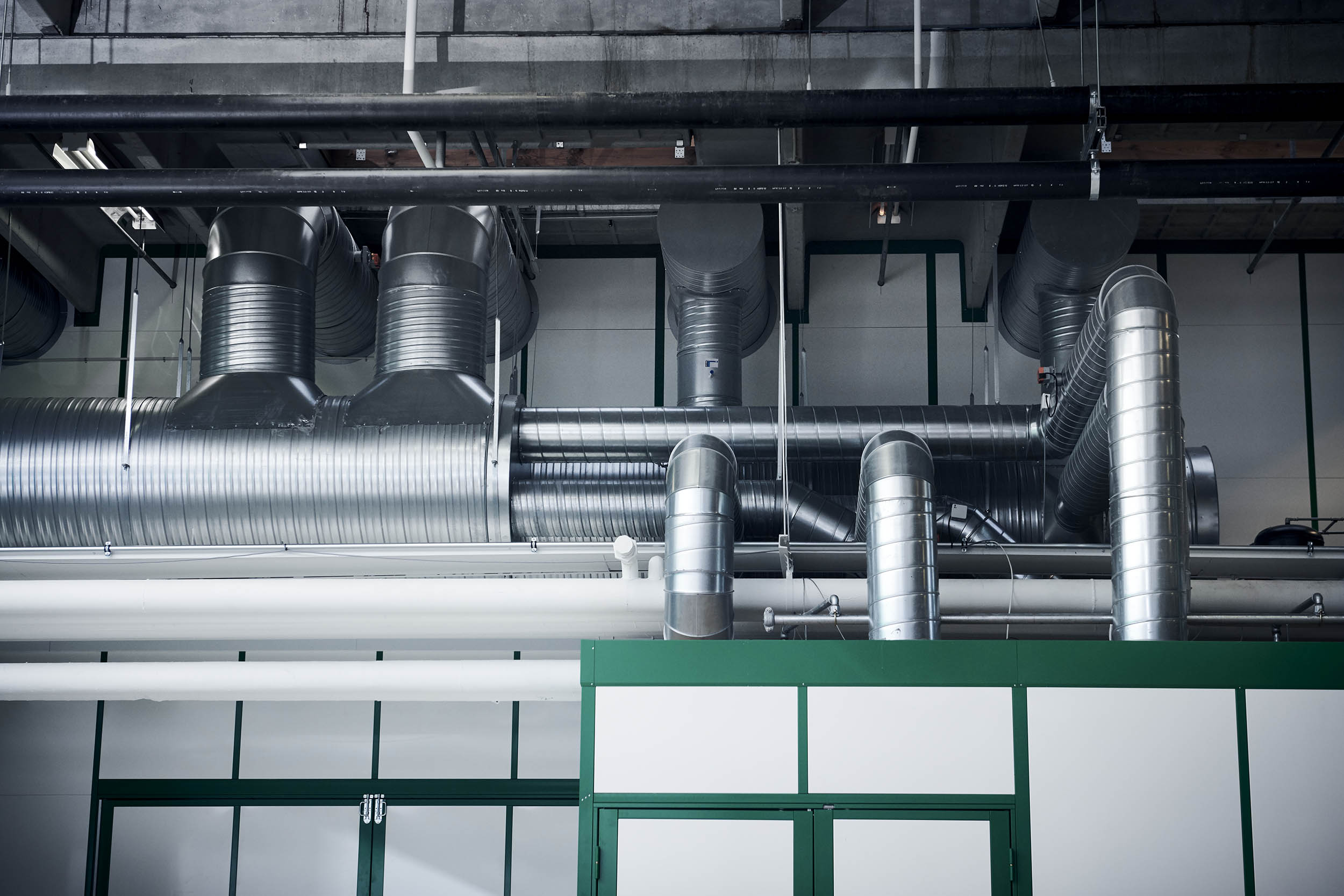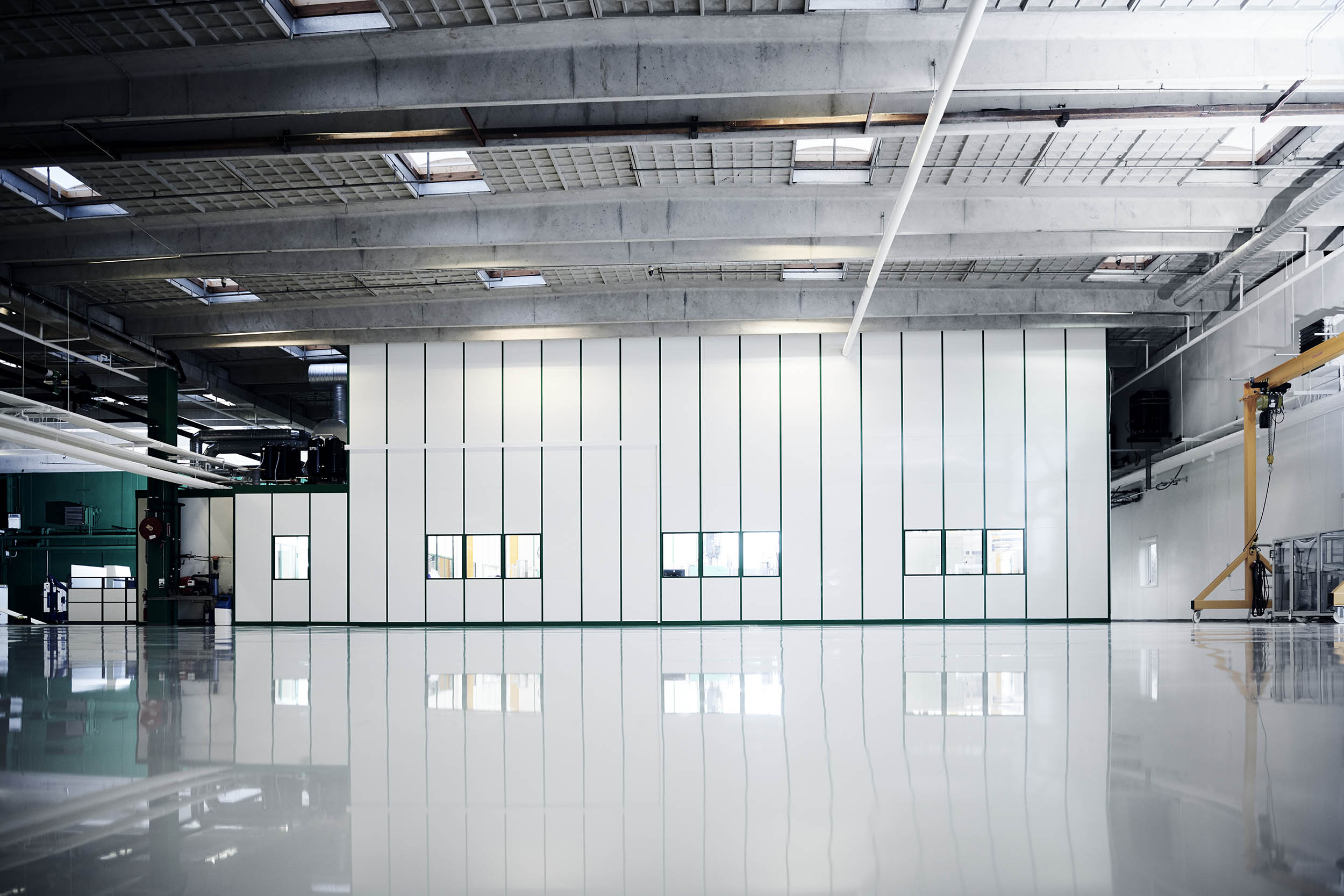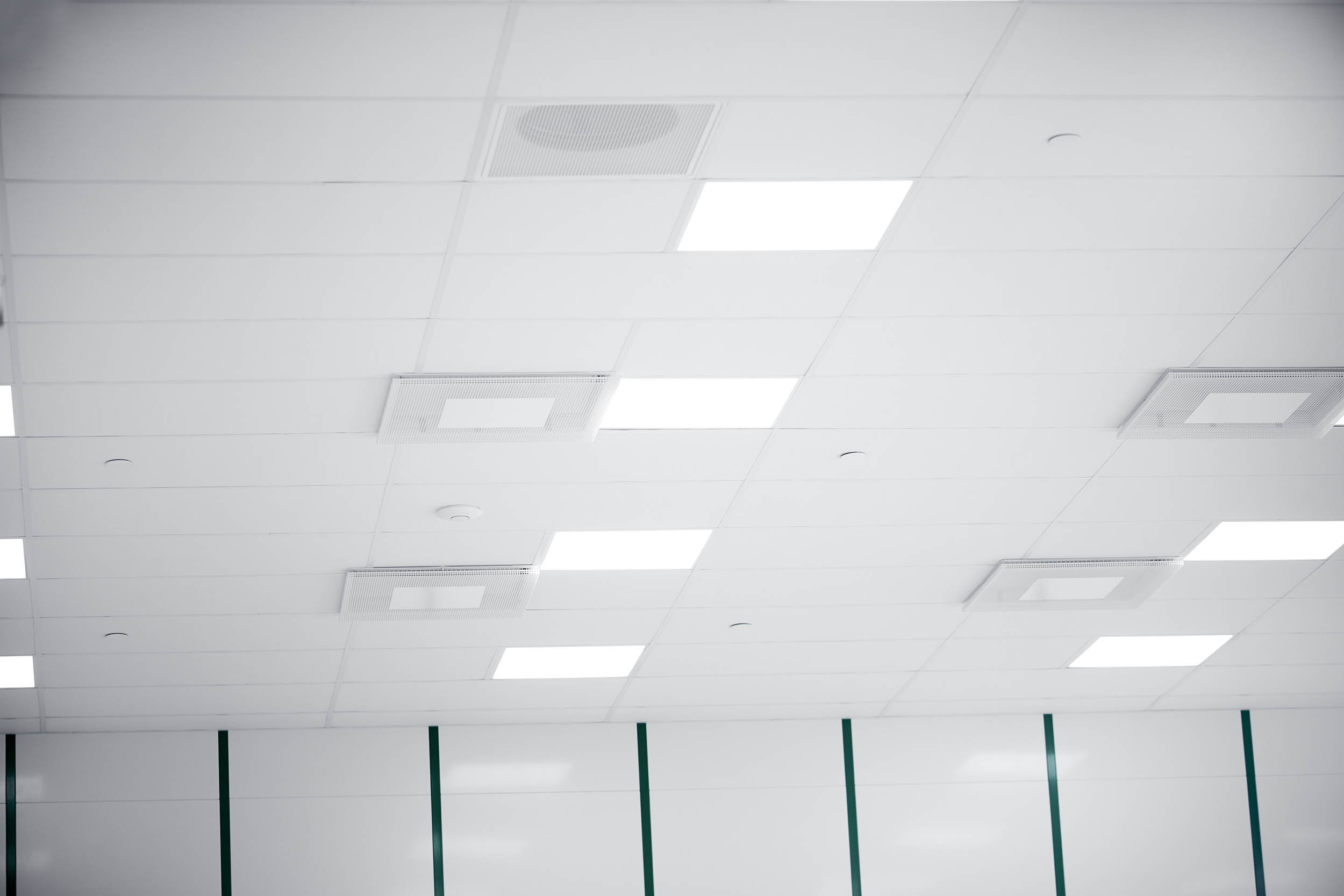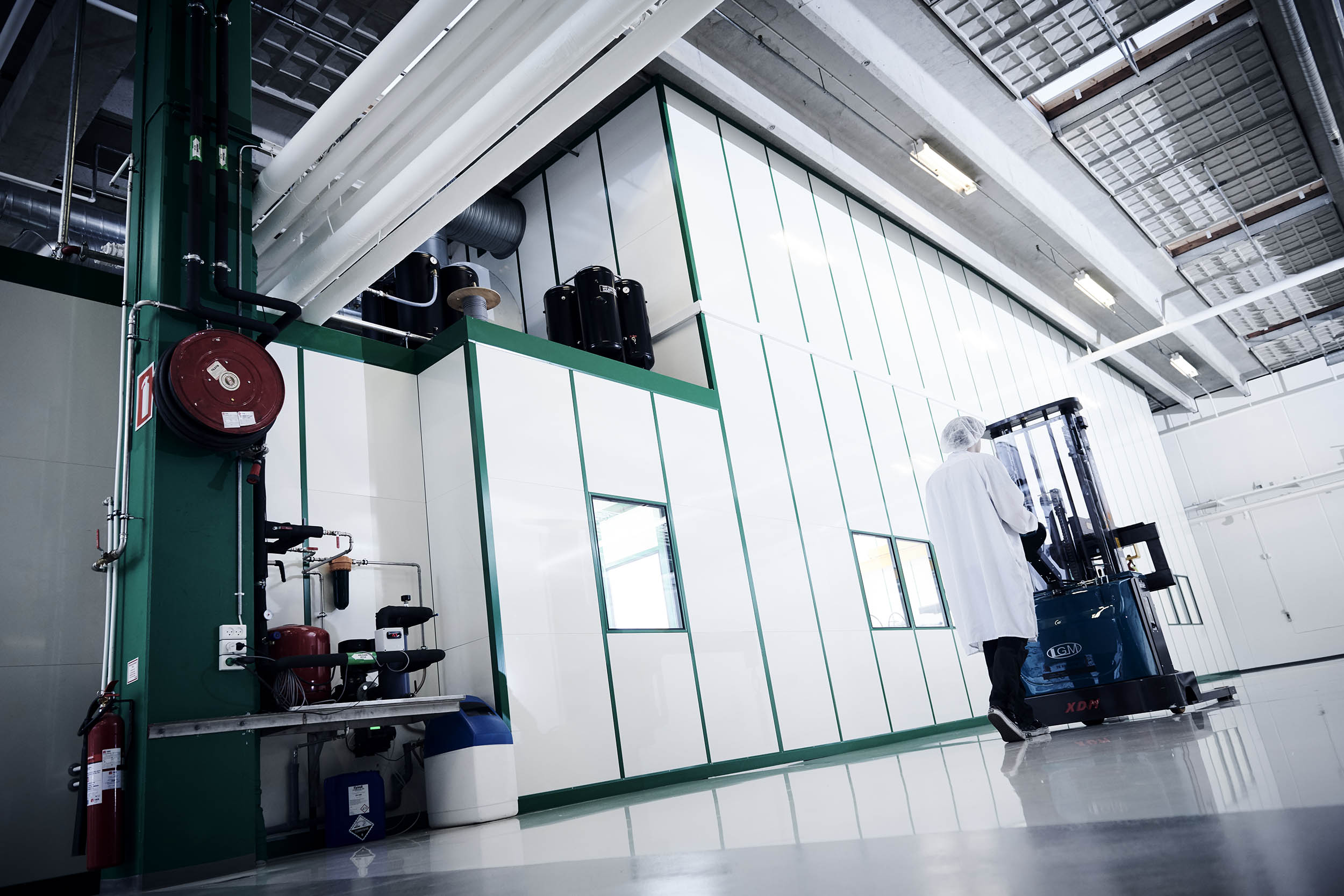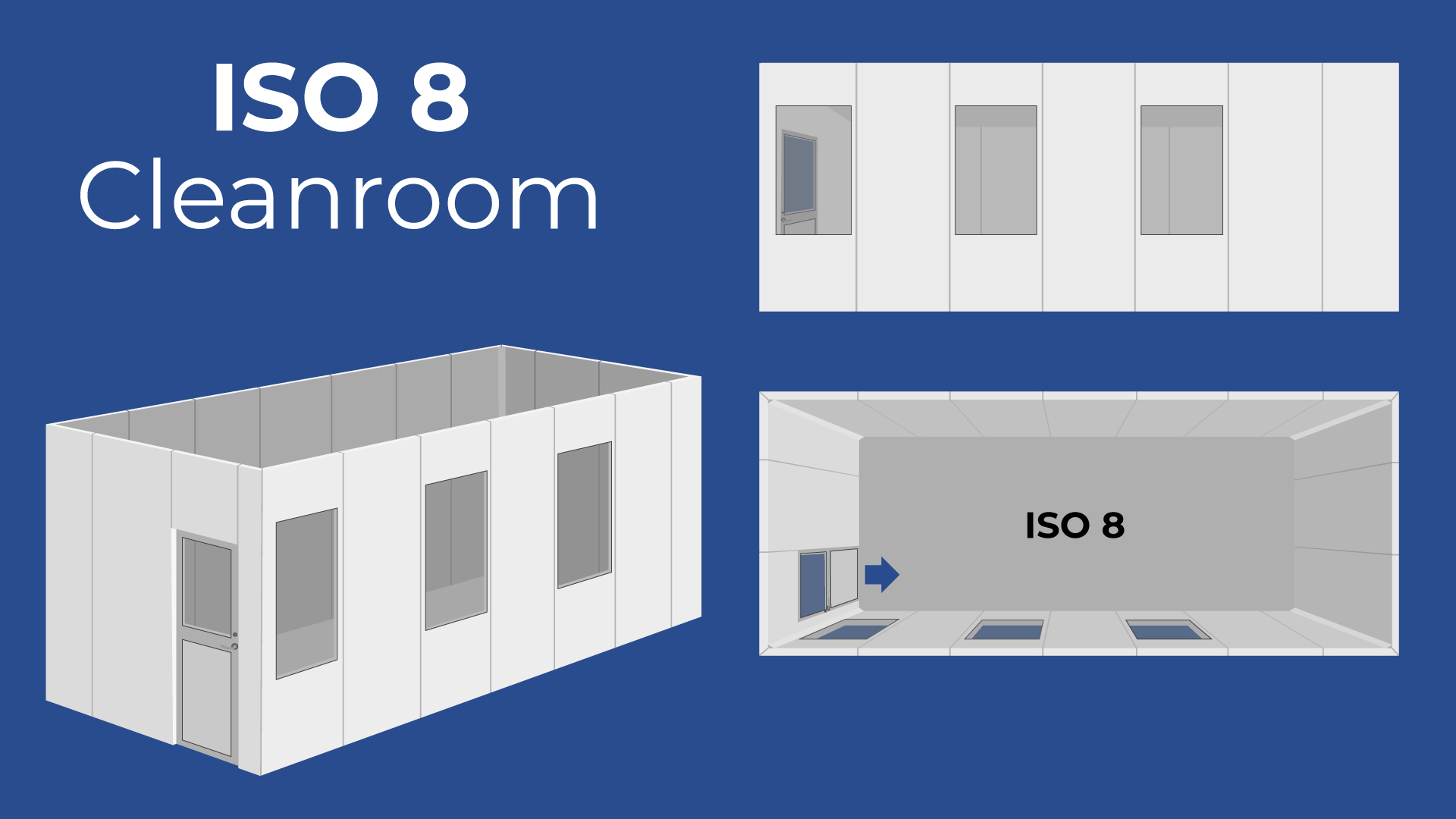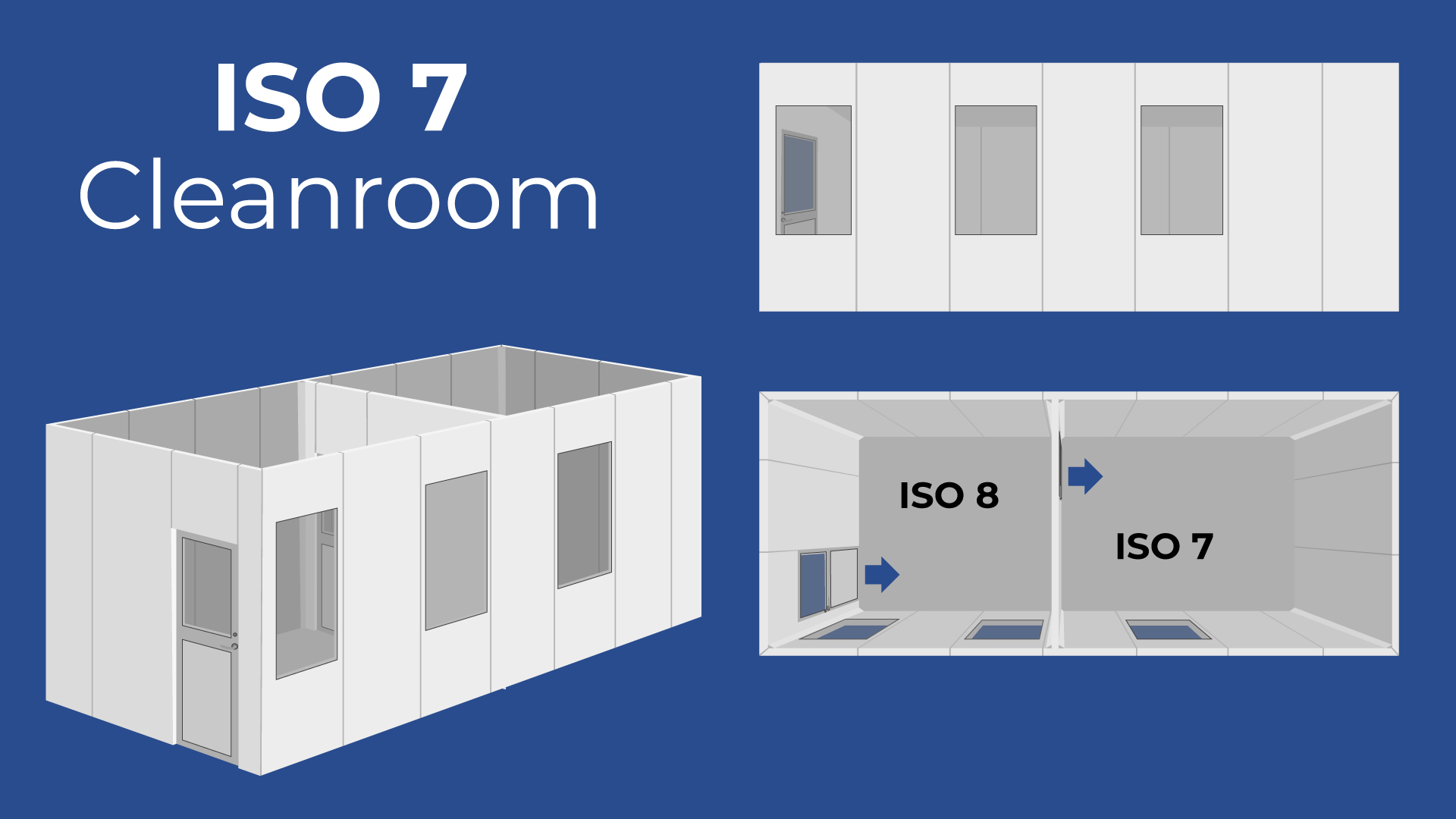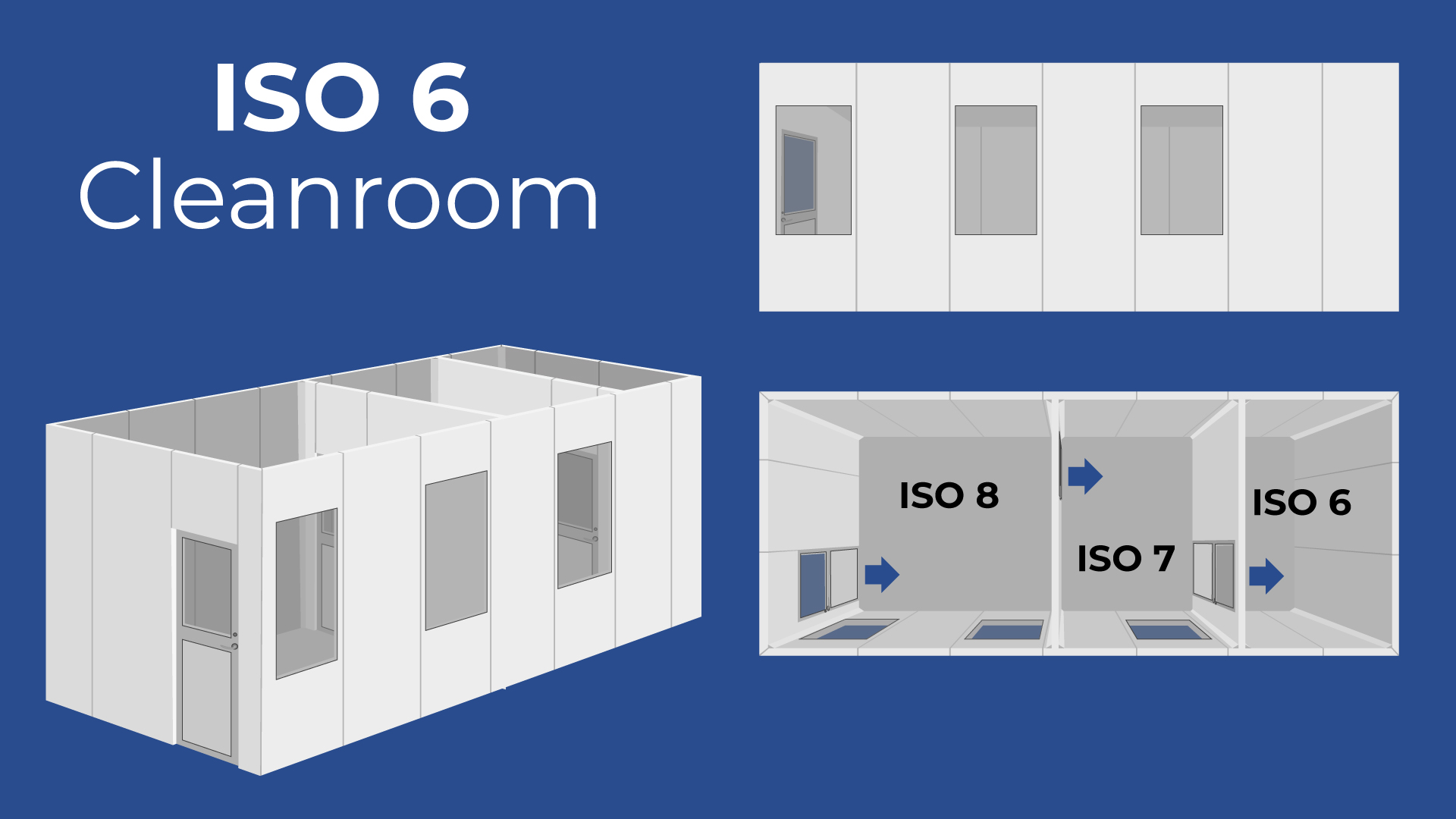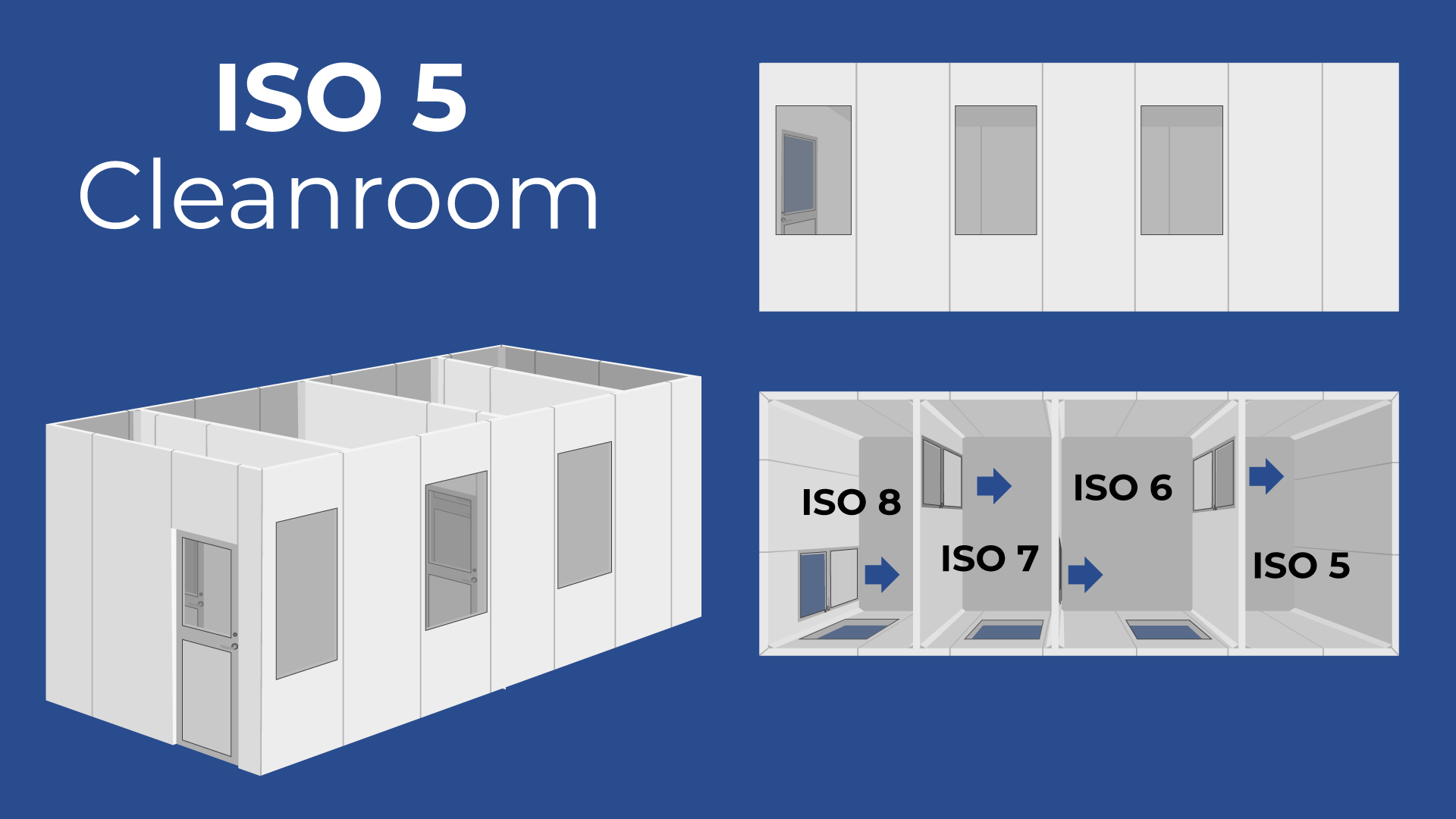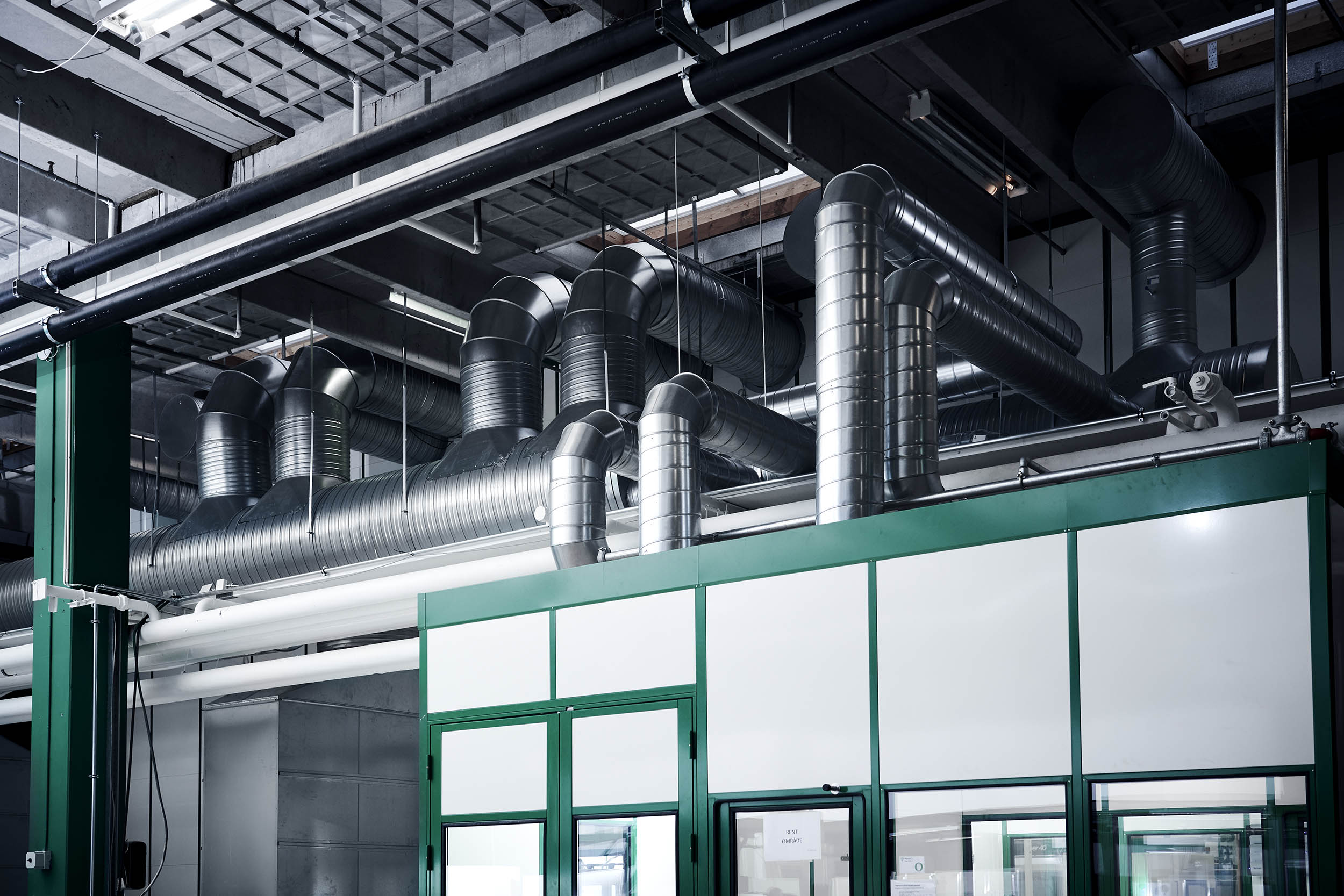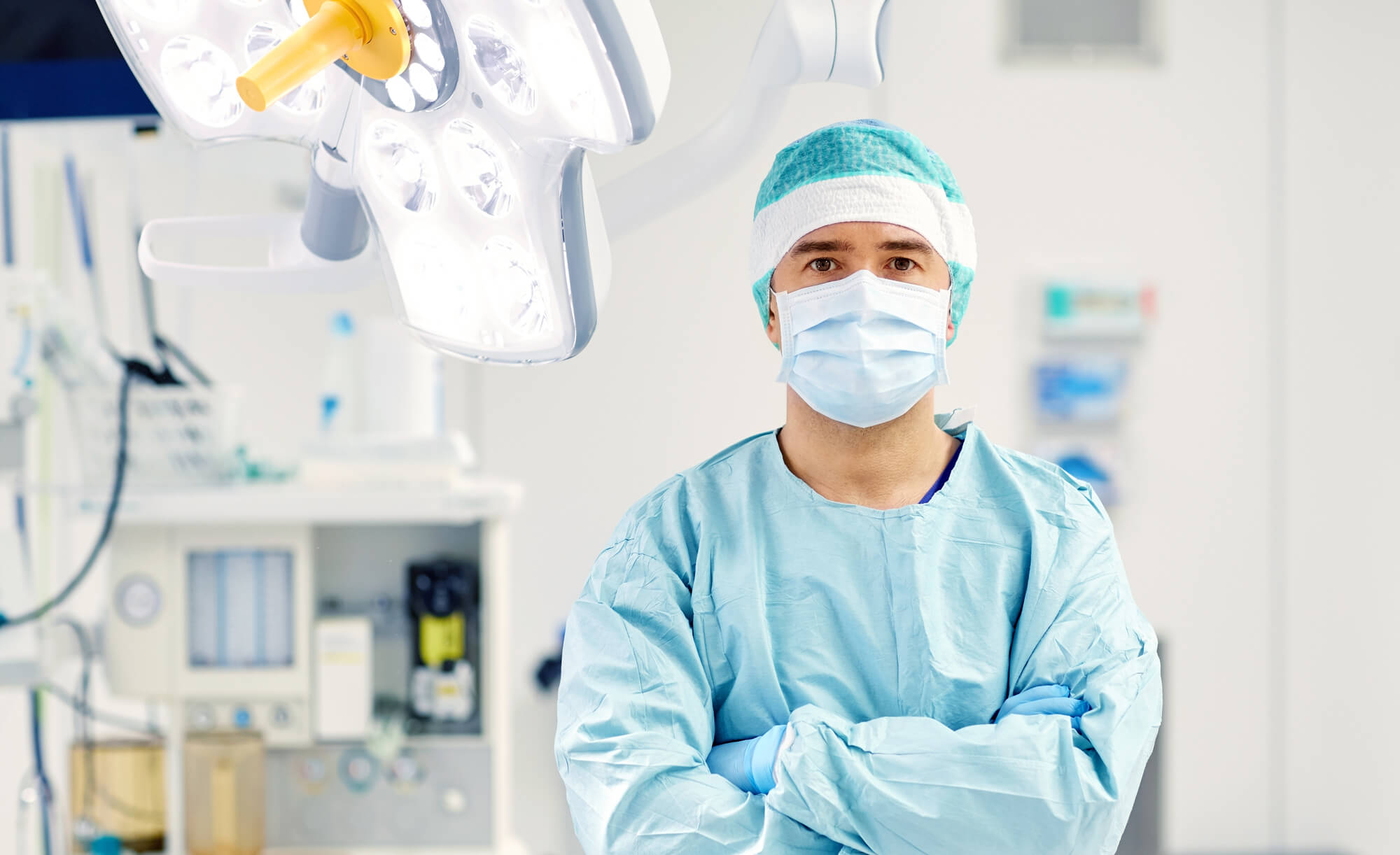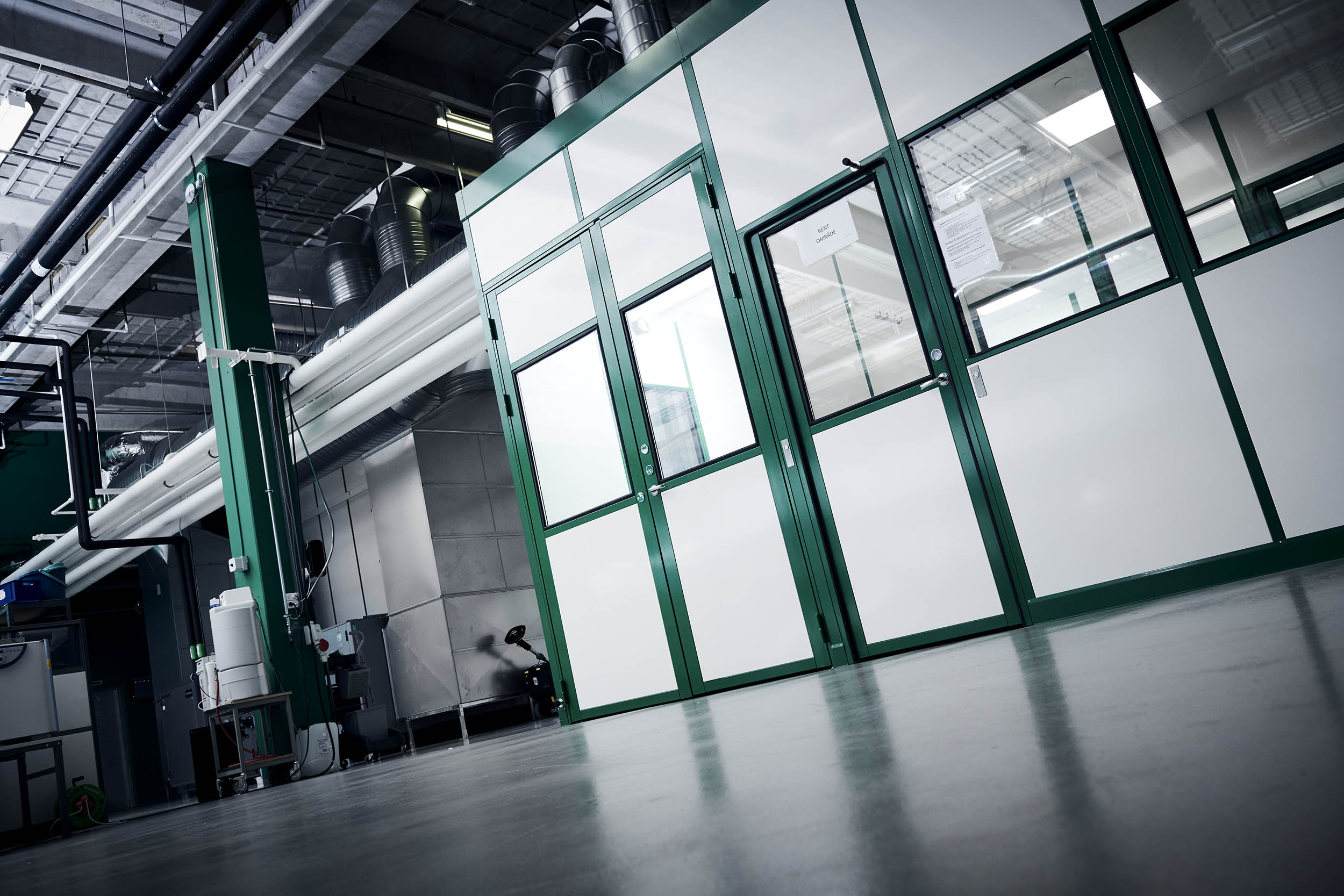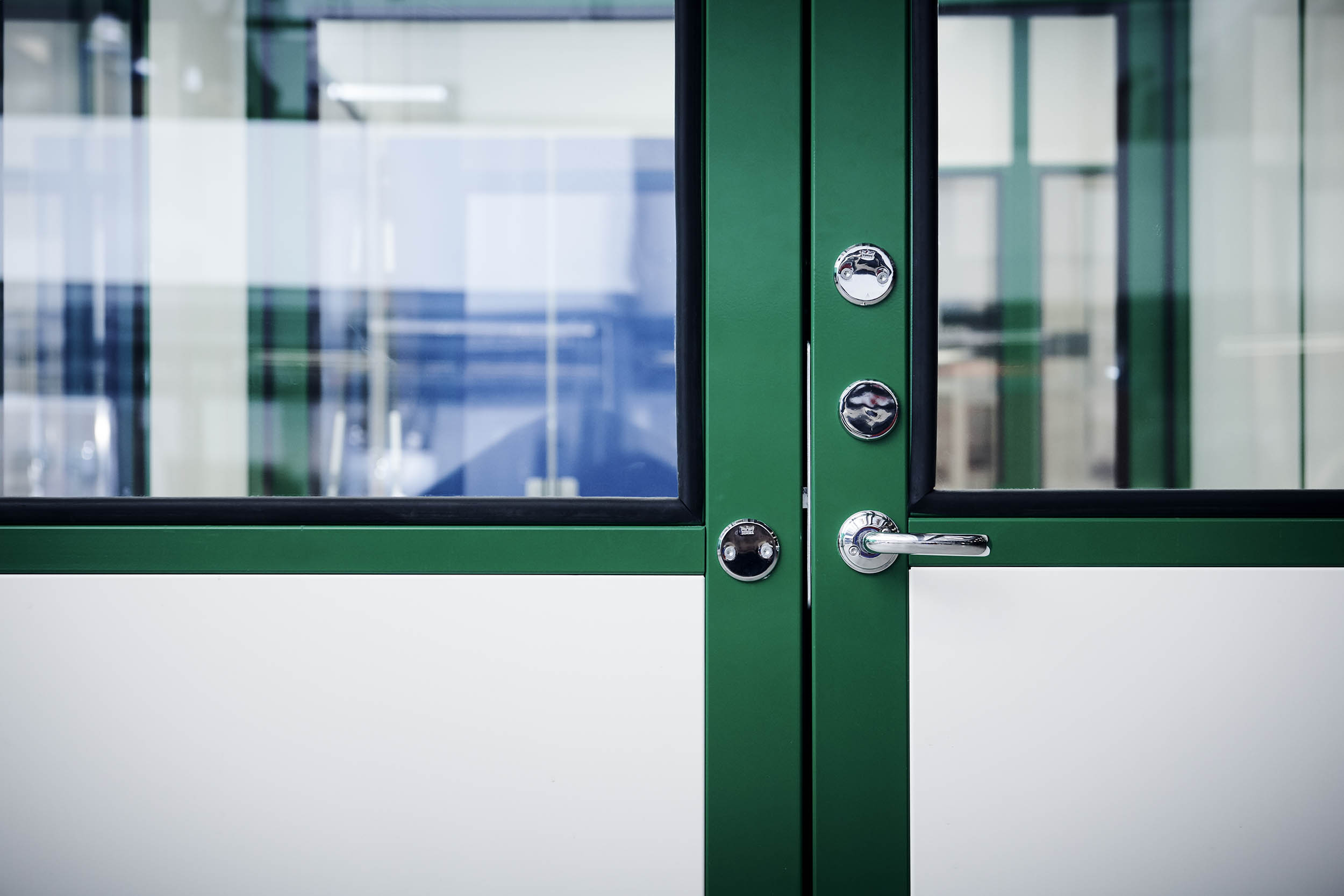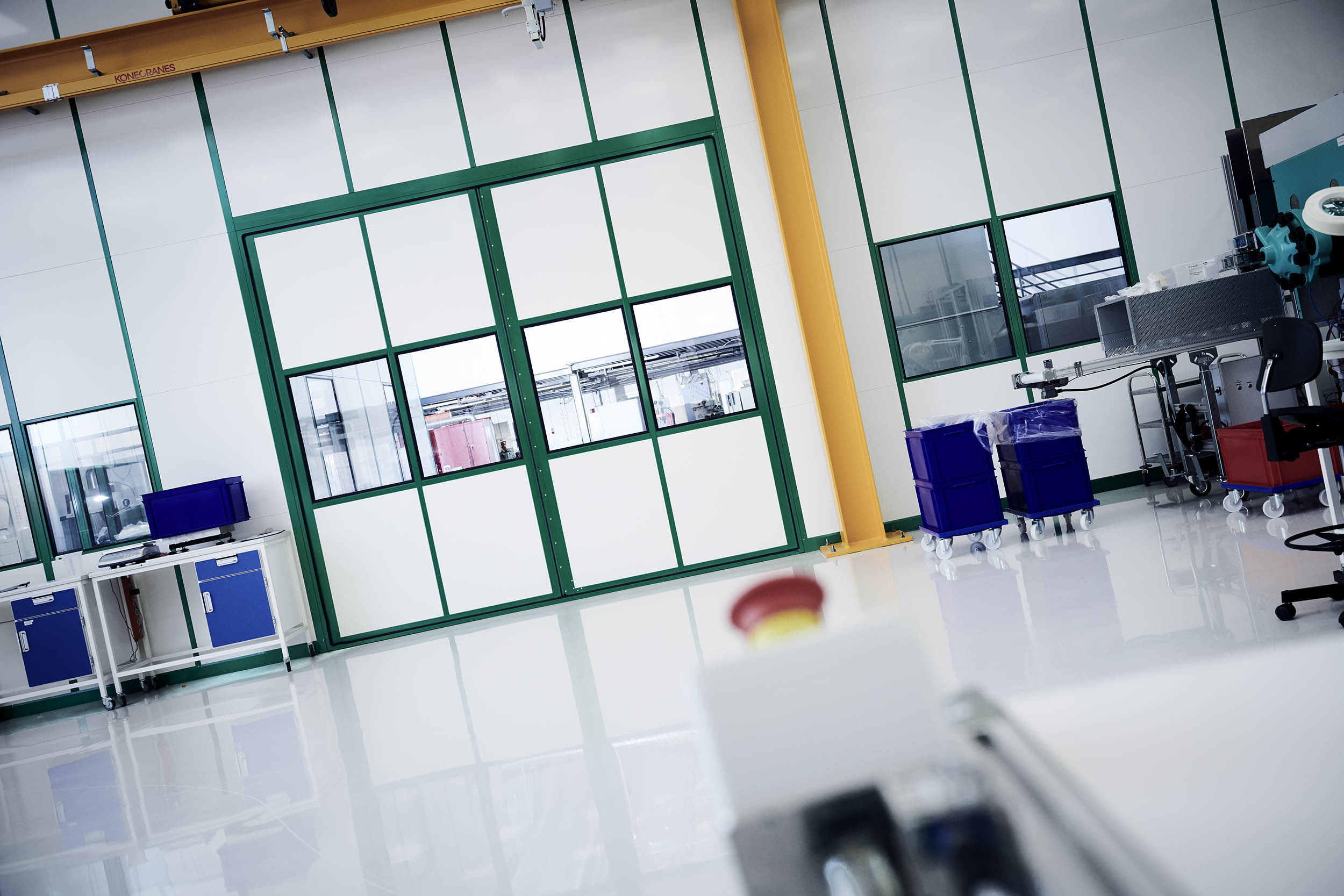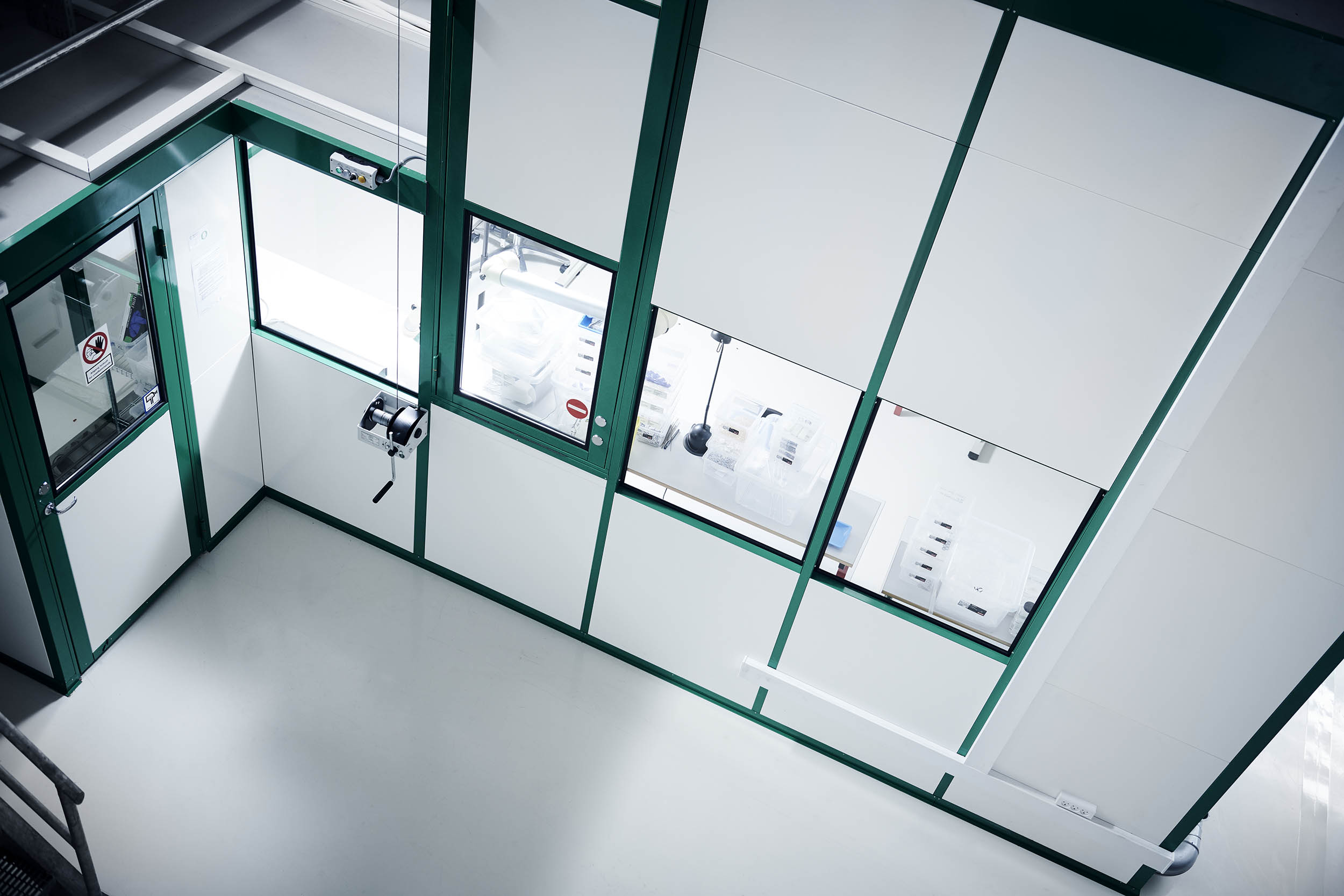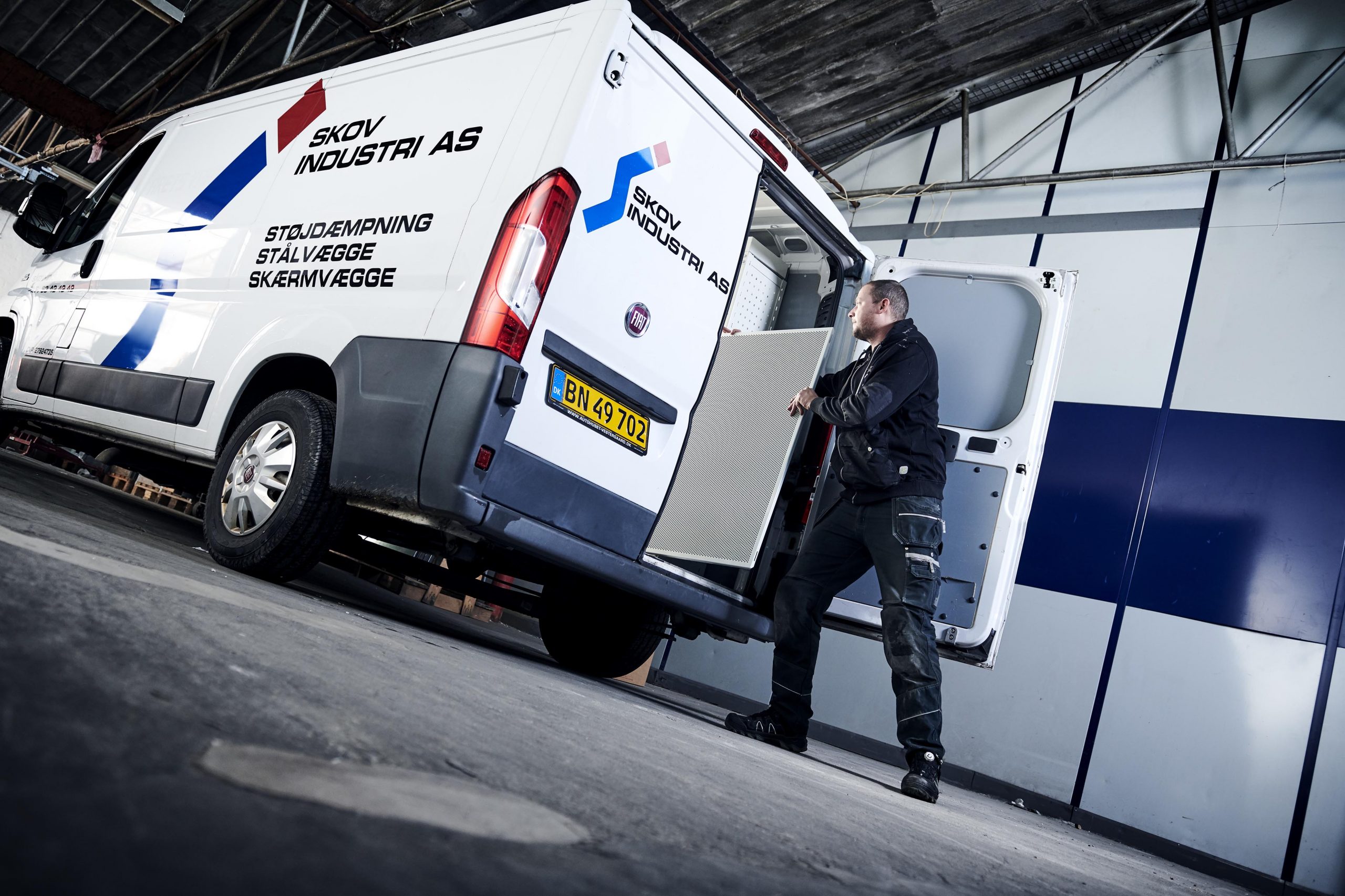Learning Centre Cleanroom
Here we share our knowledge, competence and 35 years of practical experience with cleanrooms.
Our learning centre aims to give you insight and overview through general descriptions, thumb rules, tips, and recommendations.
If you have a specific project in mind, please get in touch with us for a non-committal talk.
What is a cleanroom?
ISO standard 14644-1-4 defines a cleanroom as:
“A room in which the concentration of airborne particles is controlled, and which is constructed and used in a manner to minimise the introduction, generation, and retention of particles inside the room, and in which other relevant parameters, for example, temperature, humidity, and pressure, are controlled as necessary.”
Minimising the introduction, formation and retention of particles in a cleanroom is done in 3 ways:
- Supplying the room with a large volume of air filtered with high-efficiency filters (HEPA or ULPA) to dilute and remove particles, bacteria and chemicals inside the room. The air is also used to pressurise the room, ensuring that no contaminated air flows into the cleanroom.
- The cleanroom itself must be built with materials that do not generate pollutants, particles or airborne chemicals and must also be easy to clean.
- Cleanroom operators must wear garments that minimise the spread of particles and microorganisms generated by operators, such as hair, skin flakes, clothing fibres, etc. Note that operators make up the majority of cleanroom contamination.
Another way to explain a cleanroom is that it is a engineered and designed area that allows for precise control and monitoring and designed to regulate:
- Pressure
- Filtration
- Airflow
- Temperature
- Humidity
Read more about Skov Industri’s Cleanroom
Short animated video about cleanrooms.
Short video about clean rooms.
Why do you need a cleanroom?
The need for controlled conditions in production can be due to several factors, including:
- A customer may require your products to be produced under controlled conditions.
- Your products may require high, fine or uniform production to function properly.
- It may be that the industry requires a certain standard to be followed.
- These may be national or regional rules which means that specific standards must be followed.
Whatever the reason, it’s important to understand the requirements and rules that apply to these controlled conditions, often referred to as cleanrooms.
The operations and processes performed in the cleanroom determine which variables to control.
Cleanliness is only one of the aspects controlled in a cleanroom. Cleanrooms often also control temperature and humidity.
Here are some industries and applications that use cleanrooms:
- Pharmaceutical products
- Sterile compounding products
- Hospitals and all that enters a Hospital
- Fine electronics
- Micromechanics
- Nanotechnology
- Biotechnology
- Food
- Toxid, Dust and more, that you want to keep inside the room
If you are in doubt about whether your production is covered by cleanroom requirements, please contact us.
Classifications
ISO 14644-1-4
Cleanrooms are classified primarily by how clean the air is, according to the amount and size of airborne particles per volume of air.
Although several classifications exist, there has been an increasing trend to move from previous classification systems to the ISO classification system in ISO 14644-1-4 2015. Current versions are:
- 14644-1 : 2015
- 14644-2 : 2015
- 14644-3 : 2019
- 14644-4 : 2022
Other rules
The rules that apply to a particular cleanroom depend on the application and processes taking place inside the room.
Pharmacies with sterile compounding activities must follow the rules in USP 797, 800 or 825.
Pharmaceutical production normally follows EU GMP (A, B, C, D).
Other regulations include, but are not limited to, regional, national and international regulations such as
FDA and EMEA.
Please contact us, if you want to know more about cleanroom classifications.
Clean room conditions
The cleanroom has three different conditions:
- As built: the installation is complete, the cleanroom is in operation, but there is no equipment, materials or staff inside.
- At rest: the installation is complete and the cleanroom is running with the agreed equipment, but there is no staff inside.
- Operational: the cleanroom operates in the specified manner with the agreed equipment and specified
number of staff working in the agreed manner.
When verifying whether a cleanroom meets the requirements for cleanliness, etc., it depends on the condition of the cleanroom, and not all standards use the same condition.
Therefore, it is important to know what condition the verification requires.
Feel free to contact us if you want to know more about these cleanroom conditions.
Airflow & ventilation in cleanrooms
There are two types of cleanrooms, which differ according to their ventilation method:
Non-unidirectional airflow Cleanroom
The non-unidirectional airflow cleanroom receives clean air filtered through high-efficiency HEPA/ULPA filters in the ceiling. The fresh air is mixed with the room air and removes airborne pollution generated by people and machines through air extractors placed at the bottom of the walls.
Depending on the operations performed in the cleanroom and its size, classifications up to ISO 6 can be achieved with this ventilation method.
However, for higher and less stringent classifications such as an ISO 8, air extractors can be placed in the ceiling.
Laminar airflow Cleanroom
High efficiency HEPA/ULPA filters are installed throughout the ceiling. The air sweeps vertically into the room unidirectionally and exits through the floor, removing airborne contaminants from the room.
Since laminar airflow cleanrooms use more air and more filters, it is more expensive than non-unidirectional, but can comply with more stringent classifications, such as ISO 5 and the more stringent ISO 4, ISO 3, ISO 2 and ISO 1.
Contact us if you have any questions about cleanroom ventilation.
What is cleanroom qualification?
Clean rooms are classified according to the purity of the air in them. The cleanroom class is the cleanliness level that the room meets, according to the amount and size of particles per volume of air. The primary authority is the ISO classification system ISO 14644-1. This standard includes these cleanroom classes: ISO 1, ISO 2, ISO 3, ISO 4, ISO 5, ISO 6, ISO 7, ISO 8 and ISO 9.
ISO 1 is the “cleanest” class and ISO 9 is the “dirtiest” class. ISO 9 is still cleaner than a normal room. The most common ISO classes are ISO 7 and ISO 8.
The old Federal Standard 209 (FS 209) includes these cleanroom classes: class 100,000; 10,000; 1,000; 100; 10; 1. This standard was replaced in 1999 by ISO-14644-1. They were also withdrawn in 2001, but it is still used to some extent.
Cleanrooms must also follow industry-specific and regional standards. As mentioned, EU GMP (ABCD) applies to pharmaceutical products and USP (795, 797, 800, 825) to compound pharmacies.
Below is an approximate comparison.
Particle number for cleanroom classification
The basis for cleanroom standards is the micrometre, µm, which is the size of the particles to be filtered. As mentioned earlier, cleanrooms are classified by how clean the air is and by the amount and size of particles per volume of air. The cleanroom classification table below shows the maximum concentration limits (particles / m3 air) for particles equal to and greater than those shown.
Some classifications do not require certain particle sizes to be tested.
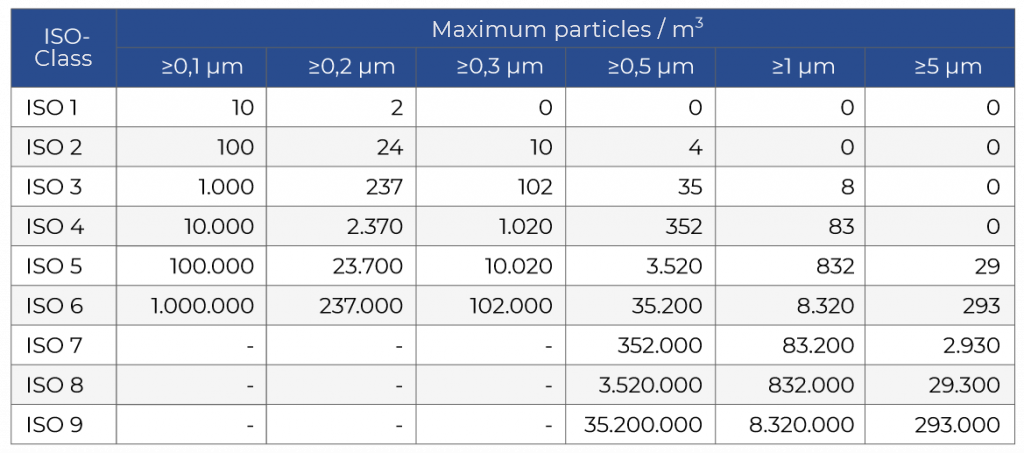
How to read the table:
For ISO 7, particles smaller than 0.5 µm are not taken into account. The concentration of particles ≥0.5 µm must be below 352,000, for particles ≥ 1 µm below 83,200 and particles ≥ 5 µm below 2,930
By comparison, a typical office building or room in your house has somewhere between 18,000,000 and 36,000,000 airborne particles of 0.5 µm or larger, for every m3.
Air change per hour
Air purity is achieved by passing the air through HEPA and ULPA filters. The more often the air passes through HEPA filters, the fewer particles remain in the room air. The air volume filtered in one hour divided by the room volume gives the number of air changes per hour.
For GMP (A, B, C, D) cleanrooms, it is a rule of thumb to use:
- 5-10 air changes per hour in GMP D rooms
- 10-12 air changes per hour in GMP C rooms
- 20-25 air changes per hour in GMP B rooms
- 30-35 air changes per hour in GMP A rooms
Below table with rule of thumb for air change at fine electronics.
Cleanroom Class and Layout
Depending on the class of cleanroom you want to achieve, it is important to make room for enough square metres. This is not only critical for the clean zone, but also for airlocks/exteriors, which prevent the migration of particles from outside into the cleanroom.
The rule of thumb is not to skip more than one class when moving towards a cleaner room (for example, from ISO 7 to ISO 6, not from ISO 8 to ISO 6). In reality, however, you can achieve a cleaner class with fewer airlocks than described below with the appropriate air changes per hour.
This depends on the process taking place inside the cleanroom, the size of the cleanroom, the number of people working inside, the equipment inside, etc.
That’s why you should always get help from a cleanroom consultant who can create the optimal layout for your specific needs.
ISO 8-CLEANROOM (CLASS 100,000) Ceiling coverage of 5-10%
Let’s assume that an unclassified room (office or laboratory) is ISO 9. In this case, you can go directly into an ISO 8 cleanroom without an airlock. However, depending on the production process inside the cleanroom, you may need to add an anteroom/personnel airlock.
- ISO 8 Cleanroom requires 15-25 air changes per hour for fine electronics
- GMP D Cleanroom requires 5-10 air changes per hour
ISO 7-CLEANROOM (CLASS 10,000) Ceiling coverage of 15-20%
This is one of the most common classes of cleanrooms. If you need an ISO 7 cleanroom, you should consider having an ISO 8 airlock/personnel airlock before entering the ISO 7 room. Air changes per hour will vary in both rooms, as described below.
- ISO 7 Cleanroom requires 30-60 air changes per hour for fine electronics
- GMP C Cleanroom requires 10-15 air changes per hour.
- ISO 8 Cleanroom requires 15-25 air changes per hour (anteroom) for fine electronics
- GMP D Cleanroom requires 5-10 air changes per hour at GMP C
ISO 6-CLEANROOM (CLASS 1,000) Ceiling coverage of 25-40%
In theory, in order for a room to achieve ISO 6 air purity, you need to enter the cleanroom through an ISO 8 personnel airlock and then go through an ISO 7 to finally enter ISO 6.
In reality, however, you can achieve an ISO 6 cleanroom with 1 (recommendation is 2) airlock. Again, it depends on the size of the room, the process that takes place inside the cleanroom, the number of people working inside, the equipment, etc.
Laminar airflow is sometimes recommended to achieve an ISO 6 classification. For a room less than 4-6 meters in width (depending on the activities taking place inside the cleanroom), the air return can be placed on the side of the walls instead of the floor. Installation of air return in the floor is more expensive.
- ISO 6 Cleanroom requires 90-180 air changes per hour for fine electronics
- GMP B Cleanroom requires 20-25 air changes per hour
- ISO 7 Cleanroom requires 30-60 air changes per hour for fine electronics
- GMP C Cleanroom requires 10-15 air changes per hour
- ISO 8 Cleanroom requires 15-25 air changes per hour (anteroom) for fine electronics
- GMP D Cleanroom requires 5-10 air changes per hour
ISO 5 CLEANROOM (CLASS 100) Ceiling coverage of 35-70%
In theory, in order for a classified room to achieve ISO 5 air purity, you need to enter the cleanroom through an ISO 8 personnel airlock and then go through an ISO 7, followed by an ISO 6 to finally enter ISO 5.
In reality, however, you can achieve an ISO 5 cleanroom with 2 or 3 airlocks. The optimal layout depends on the process taking place inside the cleanroom, the size of the room, the number of people working inside, the equipment inside, etc.
In addition, an ISO 5 cleanroom must use laminar airflow. Laminar airflow uses much more air than non-unidirectional airflow. High efficiency filters are installed throughout the ceiling. The air sweeps into the room unidirectionally and exits through the floor, removing airborne contaminants from the room. Cleanrooms using laminar airflow are more expensive than non-unidirectional ones, but can meet more stringent classifications, such as ISO 5 or lower.
- ISO 5 Cleanroom requires 240-360 air changes per hour – Laminar – for fine electronics
- GMP A Cleanroom requires 30-35 air changes per hour – Laminar
- ISO 6 Cleanroom requires 90-180 air changes per hour for fine electronics
- GMP B Cleanroom requires 20-25 air changes per hour
- ISO 7 Cleanroom requires 30-60 air changes per hour for fine electronics
- GMP C Cleanroom requires 10-15 air changes per hour
- ISO 8 Cleanroom requires 15-25 air changes per hour (anteroom) for fine electronics
- GMP D Cleanroom requires 5-10 air changes per hour
Please contact us, if you have any questions about cleanroom layout.
Air change per hour
HVAC calculations are not an easy thing. It requires a mix of technical skills, understanding of the particle-generating potential of the process and experience. Here it is crucial that you talk to a ventilation specialist who has experience with cleanrooms.
The following is based on our cooperation with various ventilation providers and is thus intended as inspiration only.
ISO classification does not dictate air changes per hour
ISO 14644-1:2015 does not specify air changes per hour (called ACH) for each cleanroom class because it depends on many factors. Air changes per hour is the number of total air changes in a room in one hour.
ISO 14644-1:2015 can only tell you the result to aim for: the maximum concentration limits for particles. For example, ISO 7 does not consider particles smaller than 0.5 µm (≥0.1 µm, ≥0.2 µm, ≥0.3 µm). The concentration of particles ≥0.5 µm must be below 352,000; particles ≥1 µm must be below 83,200; and particles ≥5 µm must be below 2,930.
However, the ISO purity level (ISO 8, ISO 7, ISO 6 and ISO 5) gives a hint about the required ACH range.
A cleanroom with activities that generate few particles versus one that generates many airborne particles, even though both are ISO 7, does not require the same air changes per hour.
Various recommendations for air change ranges and intervals can be found in many places on the Internet.
This can be summarised with our experience from working with ventilation companies to the following rule of thumb for fine electronics, etc.
- ACH 10 to 30 air changes per hour for ISO 8
- ACH 30 to 65 for ISO 7
- ACH 80 to 150 for ISO 6
- ACH 200 to 450 for ISO 5.
If there is a significant generation of particles in the process, or many people in the room, the higher number is selected in the range of the area.
For EU GMP A-D, it is a rule of thumb to use:
- ACH 5-10 for GMP D
- ACH 10-15 for GMP C
- ACH 20-25 for GMP B
- ACH 30-35 for GMP A
Note that this is only a rule of thumb!
Air exchange per hour must be calculated by an HVAC engineer based on experience and understanding of the particle generating potential of the process.
What affects cleanroom HVAC technology?
Some other elements that affect the required airflow are mentioned below.
- Cleanroom layout
- Number of people working in the cleanroom
- The equipment in the room
- Use of fume cupboard or similar. (air extraction)
- Lighting
- The pressure difference
- Outdoor temperature and humidity
Cleanroom layout
The air volume in the cleanroom will affect the required airflow and air exchange. The bigger the room, the more air you need. The width, length and height of the classified spaces and their layout must be used for HVAC calculations. One way to save costs is therefore to lower the ceiling.
Number of people working in the cleanroom
The airborne contamination in a cleanroom depends to a large extent on the activities in the room, and thus the staff. Staff are responsible for most of the particles generated in a cleanroom. The HVAC system must therefore take into account the number of people working in the room at the same time. The more people working in the cleanroom, the more airflow is needed to get rid of the contaminants. Cleanroom staff usually wear clothing to limit contamination. Therefore, it is important to maintain a comfortable environment for staff (heat, humidity, etc.)
The equipment in the room
For example, the equipment generates heat and dust. The heat increase generated by the equipment inside the cleanroom is used to determine the required cooling. The equipment in the room, together with the product manufacturing, generates dust that must be removed with the right amount of air.
Use of fume cupboard or similar. (air extraction)
A fume cupboard or the like needs a constant supply of air. This air supply must be included in the cleanroom’s HVAC calculations.
Lighting
The required lighting affects the heat generated inside the cleanroom and therefore the required cooling.
The pressure difference
The pressure should be higher in more strictly classified rooms so that the air leaks towards the less clean rooms. Positive pressure prevents dirty air from entering the cleanroom. In a clean room with negative pressure, the opposite occurs; the airflow must be greater in the adjacent room.
Outdoor temperature and humidity
If air can be recirculated in the cleanroom, the outside weather will only slightly affect the HVAC system. However, the air filling can go up to 100% of fresh air for cleanrooms working with hazardous products. In these types of cleanrooms, HVAC systems are more complex.
In winter, for example, HVAC systems need to take outside air down to -30°C in winter, warm it up to 20°C, remove the humidity and bring it back into the room again and again.
Note
The above helps you to understand the basic differences between an ISO 5, ISO 6, ISO 7 and ISO 8 cleanroom according to ISO 14644-1. Please note that this information is provided for educational purposes only. The definitions in this Learning Centre are simplified to aid understanding.
If help is needed in this regard, seek advice from an expert in your industry (pharmaceutical, medical device, sterile compounding, electronics, etc.).
You can read more about it here
But you are always welcome to contact us if you have any questions about the design of your cleanroom.
Cleanroom checklist
If you need a cleanroom checklist, please feel free to contact us.
We hope you learn something about cleanrooms.
We hope that our learning centre has made you more aware of cleanrooms and controlled production environments.
If you have ideas on how to improve our learning centre, we’d love to hear from you.
If you need any further information or have any questions, please feel free to contact us.
